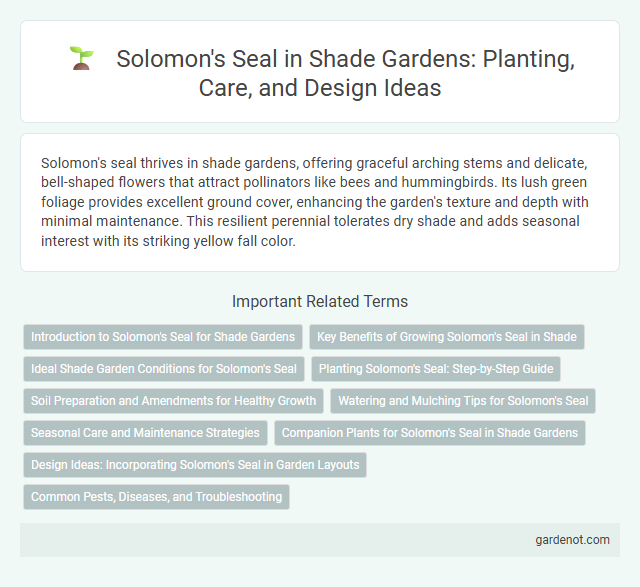Solomon's seal thrives in shade gardens, offering graceful arching stems and delicate, bell-shaped flowers that attract pollinators like bees and hummingbirds. Its lush green foliage provides excellent ground cover, enhancing the garden's texture and depth with minimal maintenance. This resilient perennial tolerates dry shade and adds seasonal interest with its striking yellow fall color.
Introduction to Solomon's Seal for Shade Gardens
Solomon's seal (Polygonatum spp.) thrives in shade gardens, offering graceful arching stems with dangling, tubular white or greenish flowers that attract pollinators. This perennial adapts well to moist, well-drained soils and provides elegant texture under trees or in shaded borders. Its natural ability to tolerate low light and its striking foliage make Solomon's seal a valuable addition to any shaded garden landscape.
Key Benefits of Growing Solomon's Seal in Shade
Solomon's seal thrives in shady garden areas, making it an ideal choice for low-light conditions where many plants struggle. Its arching stems and delicate, bell-shaped flowers add visual interest and texture to shade gardens, enhancing biodiversity by attracting pollinators such as bees and hummingbirds. This perennial also helps prevent soil erosion due to its extensive root system, promoting healthier garden ecosystems in shaded and damp environments.
Ideal Shade Garden Conditions for Solomon's Seal
Solomon's seal thrives in rich, well-drained soil with consistent moisture and prefers partial to full shade environments. This perennial plant benefits from protection against harsh afternoon sun, making it ideal for woodland gardens or shaded borders. Proper mulching helps retain soil moisture and maintains the cool, damp conditions essential for vigorous growth.
Planting Solomon's Seal: Step-by-Step Guide
Plant Solomon's Seal in shaded, well-drained soil rich in organic matter to ensure healthy growth. Space rhizomes 12-18 inches apart, planting them 1-2 inches deep with the growing tips facing upward. Water thoroughly after planting and maintain consistent moisture to promote strong root development and graceful arching stems.
Soil Preparation and Amendments for Healthy Growth
Solomon's seal thrives in well-drained, rich, loamy soil with consistent moisture for optimal growth in shade gardens. Incorporating organic matter such as compost or aged leaf mulch enhances soil fertility and structure, promoting healthy root development. Maintaining slightly acidic to neutral pH levels, between 5.5 and 7.0, supports nutrient availability essential for vigorous growth.
Watering and Mulching Tips for Solomon's Seal
Solomon's seal thrives in consistently moist, well-drained soil, requiring regular watering to keep the soil evenly damp, especially during dry spells. Applying a 2-3 inch layer of organic mulch such as shredded leaves or bark around the base helps retain moisture, regulate soil temperature, and suppress weeds. Mulching also enhances soil fertility as it decomposes, promoting healthy root development for Solomon's seal in shaded garden areas.
Seasonal Care and Maintenance Strategies
Solomon's seal requires consistent moisture and well-drained soil throughout the growing season to thrive in shade gardens. In early spring, apply a balanced, slow-release fertilizer to support new growth and periodically mulch with organic matter to retain soil moisture and suppress weeds. Pruning spent stems in late fall or early winter helps maintain plant health and encourages vigorous growth the following season.
Companion Plants for Solomon's Seal in Shade Gardens
Solomon's seal (Polygonatum spp.) thrives alongside hostas, ferns, and astilbes, forming a lush, textured understory in shade gardens. Companion plants with similar moisture and soil requirements enhance the visual appeal while promoting a healthy ecosystem. Incorporating native woodland plants like wild ginger or bloodroot can also support pollinators and enrich biodiversity.
Design Ideas: Incorporating Solomon's Seal in Garden Layouts
Solomon's Seal adds elegant arching stems and delicate white bell-shaped flowers to shade gardens, creating natural movement and texture. Planting it alongside ferns, hostas, and hellebores enhances layered foliage contrasts, ideal for woodland or shaded border designs. Its adaptability to partial to full shade and moist, well-drained soil makes it a reliable choice for under-tree plantings and shaded pathways.
Common Pests, Diseases, and Troubleshooting
Solomon's seal is susceptible to common pests such as slugs, aphids, and leaf miners, which can cause damage to its foliage. Diseases like powdery mildew and rust occasionally affect the plant, leading to discolored or spotted leaves. Regular inspection, proper drainage, and timely application of organic insecticides or fungicides help in effective pest and disease management.
Solomon’s seal Infographic

 gardenot.com
gardenot.com